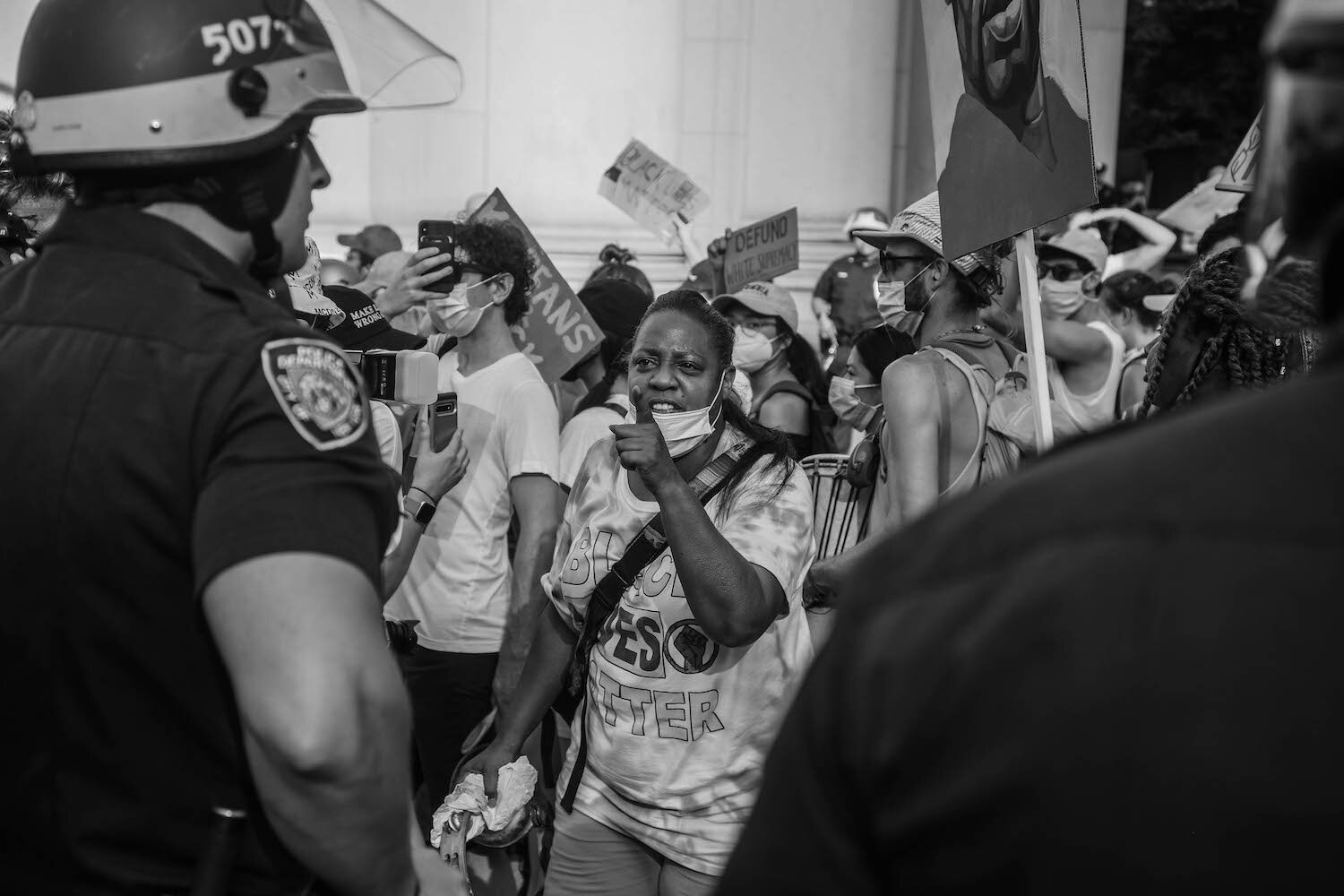In the streets
Photographer Jarrett Robertson found himself in the middle of the biggest civil rights fight in a generation. He hasn’t left since.
Sandra Mabelle protests in Washington Square Park in mid-July, following the murder of George Floyd on May 25 in Minneapolis. “I was really attracted to the aesthetic of her Afro, and how she presented her message,” Robertson says. “The Afro has meaning and power. It shows the strength of African American women. They don’t have to hide who they are.” Photography by Jarrett Robertson.
Videographer and photographer Jarrett Robertson left his Washington Heights apartment on the evening of June 4th to head downtown for a game of baseball with his then-girlfriend when he spotted a heated encounter between a group of citizens and uniformed NYPD officers. Black Lives Matter demonstrators had filled the streets that day to protest the May 25th murder of George Floyd at the hands of Minneapolis police.
“I’m a documentarian and a street photographer, so I told my friend to wait for me,” he says. “I hadn’t gone more than a block when she called and said, ‘I think I’m being arrested.’ I looked back and saw that police were arresting an innocent girl riding her cruiser.”
The incident made an impression on him. Three days after his then-girlfriend’s arrest, he committed himself to capturing images of the Black Lives Matter protests in cities across the East Coast for his Instagram feed. In the past 90 days, he’s traveled to Louisville, Chicago, Washington, D.C., and Kenosha, Wisconsin.





























Robertson grew up in the Hell’s Kitchen neighborhood of Manhattan with great-grandparents who emigrated from Czechoslovakia and grandparents from Jamaica. When he was a child, an afterschool program leader handed him and other students disposable cameras, telling them to walk the Upper East Side past Central Park and take pictures.
“The first image I took was of a puddle reflecting the sky and a family waiting for a bus surrounded by cobblestones. When I saw it, I realized that we can capture reality in a new form and--using the natural elements available--show our world from a different perspective,” he explains. “I started wondering about the story behind the family and where they were going, and realized how one picture can raise questions and tell a story at the same time.”
Robertson graduated Summa Cum Laude with a Master of Fine Arts in Media Communication Arts and Technology from the City University of New York, then worked as a videographer and music producer, as well as a photographer. “Usually, when I’m doing street photography, I don’t share my images so immediately,” he says. “But right now, I want to show what people are doing to better their community, share how I see these people who are sacrificing their time and trying to change society. The purpose of these pictures is to shed light on the future leaders and individuals on the front line who are trying to save our communities.”
“I want to show what people are doing to better their community, share how I see these people who are sacrificing their time and trying to change society. The purpose of these pictures is to shed light on the future leaders and individuals on the front line who are trying to save our communities.”
Robertson doesn’t see much media coverage of daily demonstrations and peaceful protests. Rather, he says, reporters show up when an event looks like it might turn into a violent confrontation. While he’s shot numerous images of people in altercations with the police, he’s as interested in capturing moments of intimacy and even whimsy at the protests, as in the image of the Labradoodle wearing a cardboard sign that reads “Heck All Racists.” “I want to show the good that people are doing,” Robertson says.
A favorite among his photographs shows a young Black woman in an Afro holding a cardboard sign that reads “You fucked with the wrong generation.” She wears a bikini top and white mask that says ‘No justice, no peace,” and she’s written “I can’t breathe” in black marker on her chest. “This image sums up the whole movement,” Robertson says.
When he’s out on the streets with his camera, physical danger is a given, though his new zoom lens allows him to stay further back from any violence. He’s wary of the police. “I always thought they would show respect for the press and an understanding of what we’re doing,” he says. “But they pin us in with the protestors and have no restraints when it comes to physical injuries and pepper spray.”
“I always thought (the police) would show respect for the press and an understanding of what we’re doing. But they pin us in with the protestors and have no restraints when it comes to physical injuries and pepper spray.”
Robertson is attempting to raise money so that he travel to cities such as Rochester, New York and Portland, Oregon to document the protests there. In the meantime, he plans to keep photographing in New York, though the protests appear to be waning. “I used to see six blocks full of people, and now on a good day, there are fifty or sixty people out,” he says. “The city is open again, and people have jobs and other priorities that they can’t ignore.”
He notes that he’ll have a more solid grasp on his plans for the future after the presidential election in November; regardless of the results, he says, people are crying out for human rights, and he wants to document their voices.
“My life has been turned upside down,” he says. “Following the Black Lives Matter movement has given me some hope and direction for the future, but at the same time I feel like I’ve jumped out of an airplane and I haven’t pulled the parachute yet and I’m still in free fall. I don’t know where I’m going to land. I just hope the parachute works and I land in a place better than where I started.”

